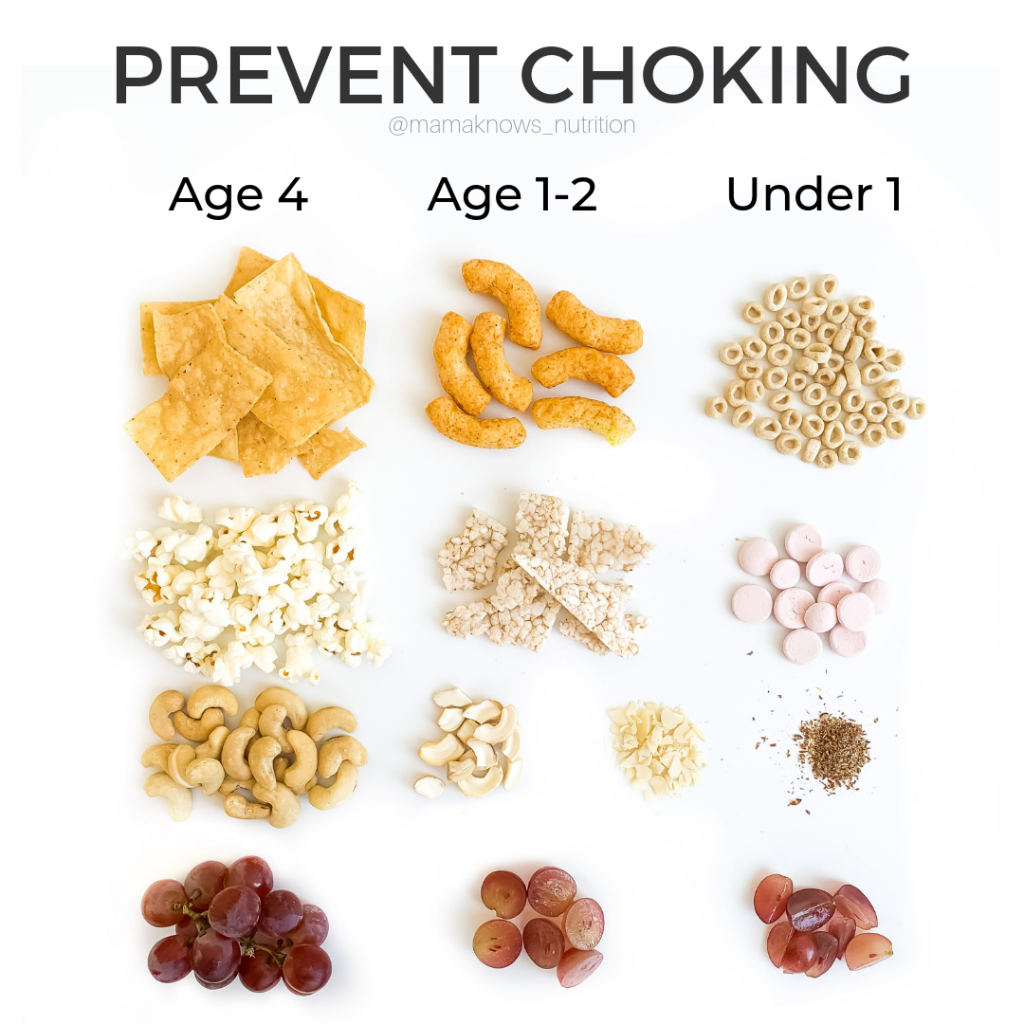Which Foods are Choking Hazards for Toddlers
Oct 16, 2019, Updated May 13, 2025
This post contains affiliate links. Please see our disclosure policy.
It’s important to familiarize yourself with choking hazards for toddlers, as their risk for choking continues past the baby phase!
The only time my son choked was when he was 2 years old. We were at a party, he was running around, and he was eating fruit. The combination of an unripe piece of melon (too hard) and running around caused him to choke.
Thank GOD I was with him and knew what to do but it was absolutely terrifying. I was yelling for help but since we were at a party, it was so loud that no one could hear me yelling.
A few back blows dislodged the melon and he kind of cough/hurled it out. I just can’t imagine what would have happened if I wasn’t watching him when he choked.
Ways to Help Prevent Your Toddler From Choking
Some things to make sure of for babies and children of all ages:
- Eat while sitting upright (not laying down or reclined)
- Eat while sitting, not walking, running, or jumping
- Avoid eating in the car or stroller
- Make sure your child is supervised while eating
What to do if Your Toddler is Choking
KNOW WHAT TO DO! It’s always scary when your toddler chokes, but it’s much less scary if you know what to do to help them. These are guidelines for children ages 1 and up.
If it’s a partial obstruction:
- they will be coughing, might be able to talk or make sounds- this means air is still coming through
- you should encourage them to keep coughing. You do not need to touch them or intervene at this point
- Stay close by and keep encouraging coughing until they’ve cleared the item
If it’s a complete obstruction:
- they will NOT be able to cough or talk
- they may put their hands on their neck to show you they’re choking, eyes may go wide, lips may begin to turn blue
- Learn how administer proper back blows and abdominal thrusts – this online course (you can do it during nap time, it’s quick!) is amazing and prepares you with all the info you need (use code kacie10 for a discount!)
This isn’t a time to be afraid to hurt them. You need to get the object OUT.
Choking Hazards for Toddlers
I’m going to list the most important choking hazards by age, and give you guidelines of how and when to advance to the next stage. But remember that these are just approximate guidelines and what’s best for your child may vary from what you see here. For example, children with disabilities or developmental delays may not be ready until much later than the ages I suggest.
Always make sure an adult is present when a child is eating, because you want someone to be there to respond immediately if they have any issues.

All ages
Very hard, crunchy, sticky, or chewy foods can be more difficult. These foods are best for children 4 and up, but even then, I would make sure that these foods are cut to an appropriate size and the child is eating slowly.
Under 1 year old
- Foods should be soft enough that they can easily mash or the food will dissolve easily in their mouth
- Food size: When starting with finger foods-
- pieces can be “french fry” shape, think about the size of your pinky finger
- or cut into small pieces, like the size of a Cheerio
- Common choking hazards:
- NUTS: finely ground nuts or peanuts are okay, or use nut butter (just not big globs of it, that can be hard to swallow)
- GRAPES AND TOMATOES: quarter them
- RAW VEGGIES: either cook the veggie, or serve it grated
- APPLE: cooked, shredded, or sliced paper thin
- CHIPS: avoid
- DRIED FRUIT: cook or soak in hot water to soften
- HOT DOGS: avoid under age 1 for high sodium, but if they are having a few bites, make sure they are chopped into small pieces
- POPCORN: avoid
- MEAT: skin should be avoided; take caution with meat served on the bone, as you don’t want any bone pieces to break off
- serve ground or very tender (well cooked and soft) meat
- Begin teaching them to take bites from soft foods if you typically cut all their food small (you can start with something like banana, or bread)
If you’re just starting to feed your baby, I would HIGHLY recommend my Simply Solids quick start guide!
AGES 1 to 2
I’m giving this wide range because toddlers advance at different speeds. Some have been feeding themselves finger foods since around 6-8 months, some don’t start until closer to 1.
And remember you can always change your mind on something! If it seems like they’re having a difficult time chewing something, just hold off for another couple of months on that food.
- Common choking hazards for toddlers:
- NUTS: finely chopped nuts and seeds; cashews are a good first choice since they’re a softer nut than most others. I’d wait until around age 3-4 to introduce bigger pieces of nuts, because we want them to have the ability to grind their food well
- GRAPES AND TOMATOES: halve lengthwise
- RAW VEGGIES: shredded or very thinly sliced
- APPLE: shredded or very thinly sliced
- CHIPS: avoid chips and tortilla chips
- choose puffed snacks (think Pirate’s Booty texture), most crackers (as long as they are not very sharp and crunchy), thin rice cakes
- DRIED FRUIT: small raisins are okay, otherwise chop small or cook/soak in hot water to soften
- HOT DOGS: halve lengthwise and cut into pieces
- POPCORN: avoid
- I do see people serving popcorn at this age – if you’re going to do it, make sure your child is seated and eating one piece at a time, and if you can break it into smaller pieces for them I would
- MEAT: avoid skin; use caution with bones; serve ground or very tender meat and avoid large chunks/cubes of meat that may be difficult to chew
AGE 4 and up
At around age 4, children are able to chew more thoroughly and grind their food well. Again, this age will vary from child to child. You don’t HAVE to give them whole grapes and whole hot dogs just because they are now 4.
Children can choke at any age, so it’s always important to remind them to stay seated while eating, avoid talking while chewing, eat slowly, and take small bites!
Non-Food Choking Hazards for Toddlers
This is a reminder that often when babies and toddlers do choke, it’s can be on non-food objects. Do your best to keep your toddler away from these:
- Latex balloons
- Coin
- Marbles
- Beads
- Toys with small parts
- Pen or marker caps
- Small balls
- Button batteries
Toddler-Friendly Recipes
If you’re looking for recipes that will be healthy and your toddler will LOVE, grab a copy of my Meal & Snack Survival Guide!

This guide has delicious recipes for breakfasts, snacks, and treats. All recipes have NO sugar added – they are sweetened only with fruit!
You may also be interested in:
Ultimate Guide to Low Sugar Cereal for Toddlers













